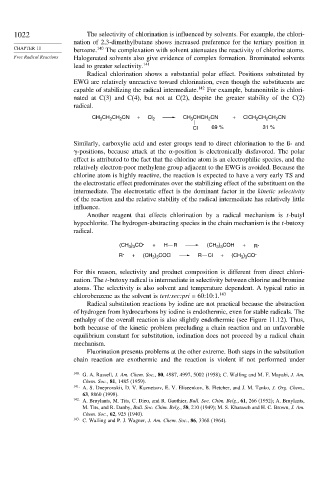Page 1038 - Advanced Organic Chemistry Part A - Structure and Mechanisms, 5th ed (2007) - Carey _ Sundberg
P. 1038
1022 The selectivity of chlorination is influenced by solvents. For example, the chlori-
nation of 2,3-dimethylbutane shows increased preference for the tertiary position in
CHAPTER 11 benzene. 140 The complexation with solvent attenuates the reactivity of chlorine atoms.
Free Radical Reactions Halogenated solvents also give evidence of complex formation. Brominated solvents
lead to greater selectivity. 141
Radical chlorination shows a substantial polar effect. Positions substituted by
EWG are relatively unreactive toward chlorination, even though the substituents are
capable of stabilizing the radical intermediate. 142 For example, butanonitrile is chlori-
nated at C(3) and C(4), but not at C(2), despite the greater stability of the C(2)
radical.
CH CH CH CN + Cl 2 CH CHCH CN + ClCH CH CH CN
2
2
3
2
3
2
2
2
Cl 69 % 31 %
Similarly, carboxylic acid and ester groups tend to direct chlorination to the ß- and
-positions, because attack at the -position is electronically disfavored. The polar
effect is attributed to the fact that the chlorine atom is an electrophilic species, and the
relatively electron-poor methylene group adjacent to the EWG is avoided. Because the
chlorine atom is highly reactive, the reaction is expected to have a very early TS and
the electrostatic effect predominates over the stabilizing effect of the substituent on the
intermediate. The electrostatic effect is the dominant factor in the kinetic selectivity
of the reaction and the relative stability of the radical intermediate has relatively little
influence.
Another reagent that effects chlorination by a radical mechanism is t-butyl
hypochlorite. The hydrogen-abstracting species in the chain mechanism is the t-butoxy
radical.
(CH ) CO . + H R (CH ) COH + R .
3 3
3 3
R . + (CH ) COCl R Cl + (CH 3 3 .
) CO
3 3
For this reason, selectivity and product composition is different from direct chlori-
nation. The t-butoxy radical is intermediate in selectivity between chlorine and bromine
atoms. The selectivity is also solvent and temperature dependent. A typical ratio in
chlorobenzene as the solvent is tert:sec:pri = 60:10:1. 143
Radical substitution reactions by iodine are not practical because the abstraction
of hydrogen from hydrocarbons by iodine is endothermic, even for stable radicals. The
enthalpy of the overall reaction is also slightly endothermic (see Figure 11.12). Thus,
both because of the kinetic problem precluding a chain reaction and an unfavorable
equilibrium constant for substitution, iodination does not proceed by a radical chain
mechanism.
Fluorination presents problems at the other extreme. Both steps in the substitution
chain reaction are exothermic and the reaction is violent if not performed under
140 G. A. Russell, J. Am. Chem. Soc., 80, 4987, 4997, 5002 (1958); C. Walling and M. F. Mayahi, J. Am.
Chem. Soc., 81, 1485 (1959).
141
A. S. Dneprovskii, D. V. Kuznetsov, E. V. Eliseenkov, B. Fletcher, and J. M. Tanko, J. Org. Chem.,
63, 8860 (1998).
142 A. Bruylants, M. Tits, C. Dieu, and R. Gauthier, Bull. Soc. Chim. Belg., 61, 266 (1952); A. Bruylants,
M. Tits, and R. Danby, Bull. Soc. Chim. Belg., 58, 210 (1949); M. S. Kharasch and H. C. Brown, J. Am.
Chem. Soc., 62, 925 (1940).
143
C. Walling and P. J. Wagner, J. Am. Chem. Soc., 86, 3368 (1964).

